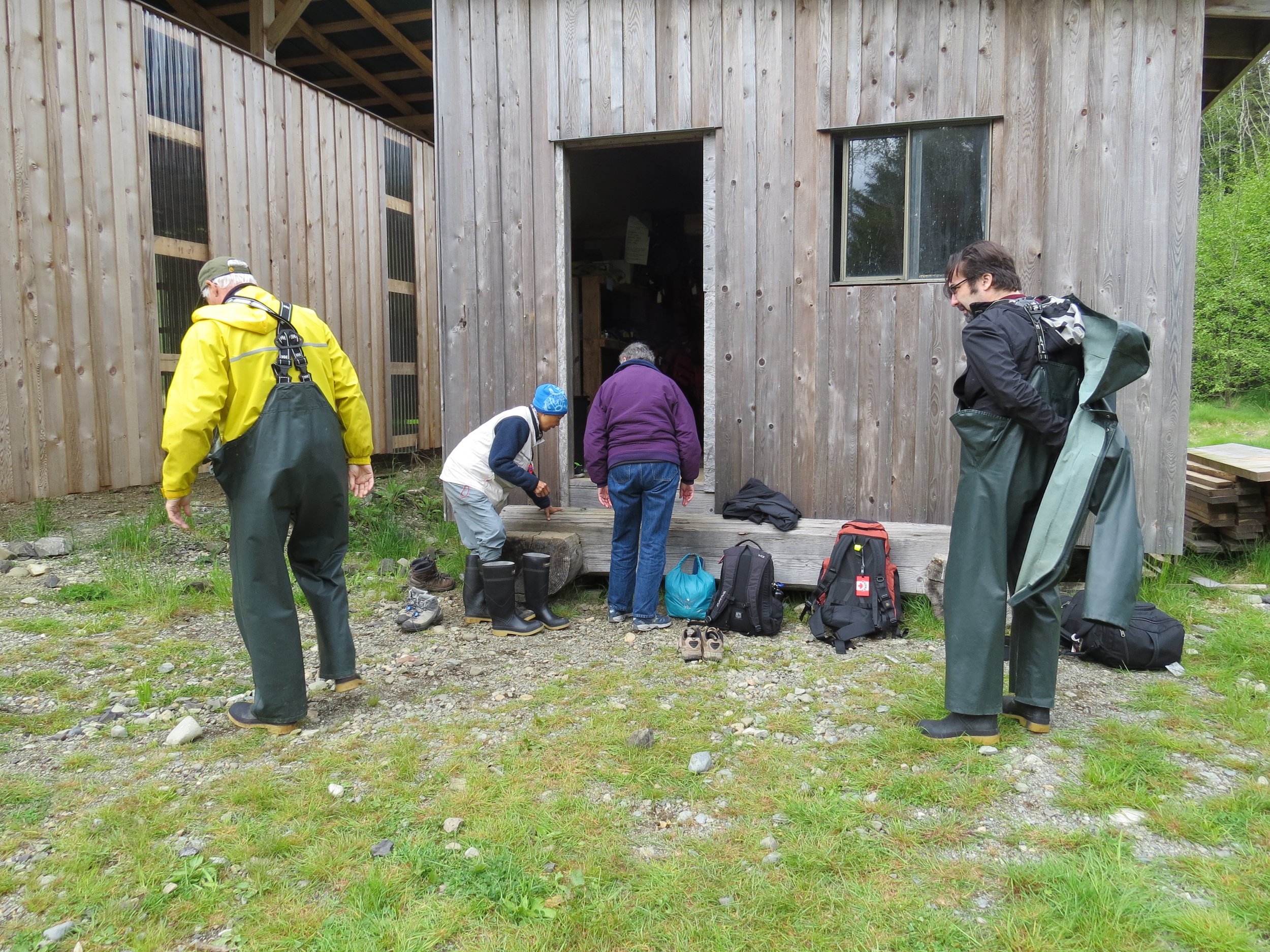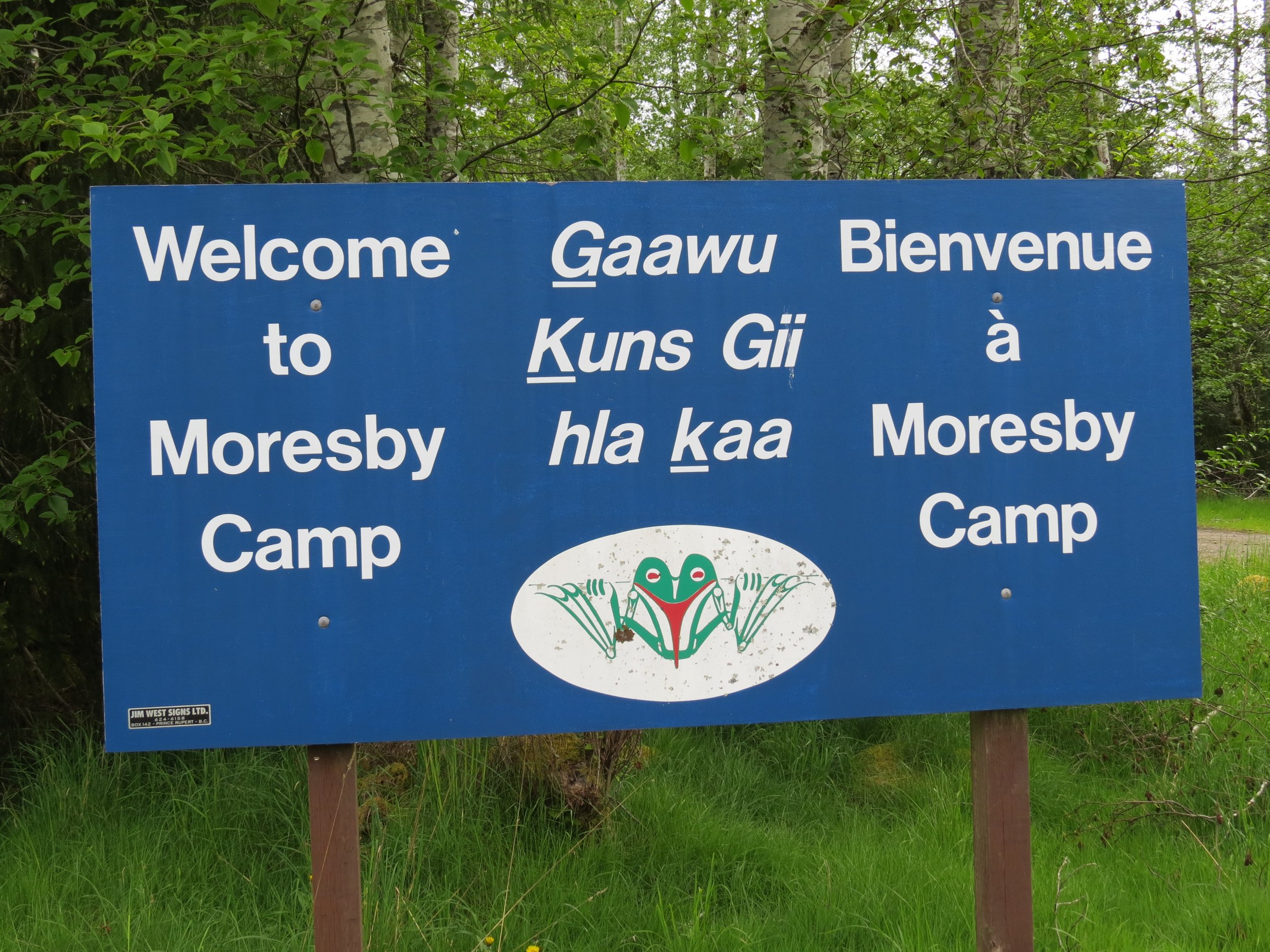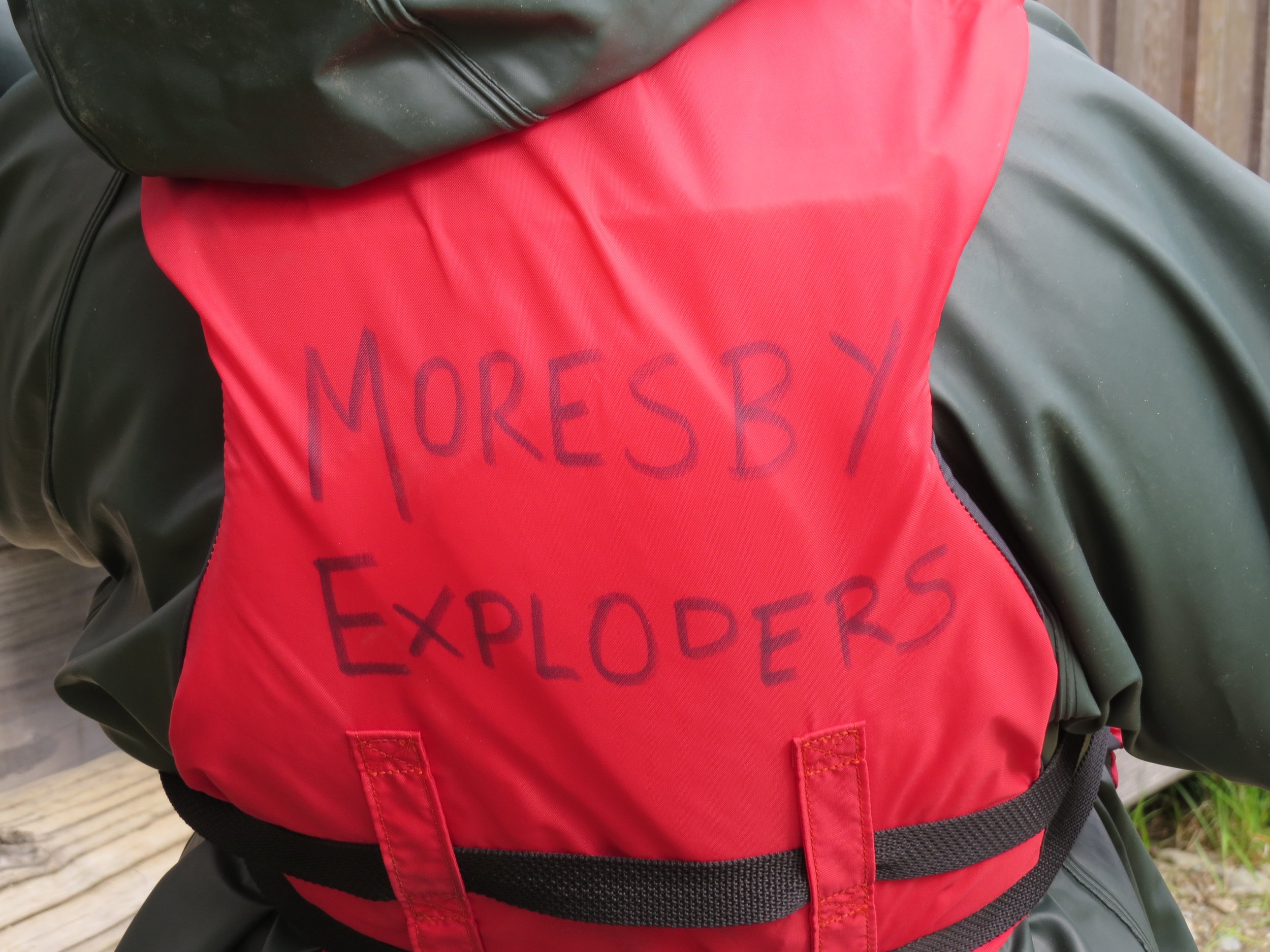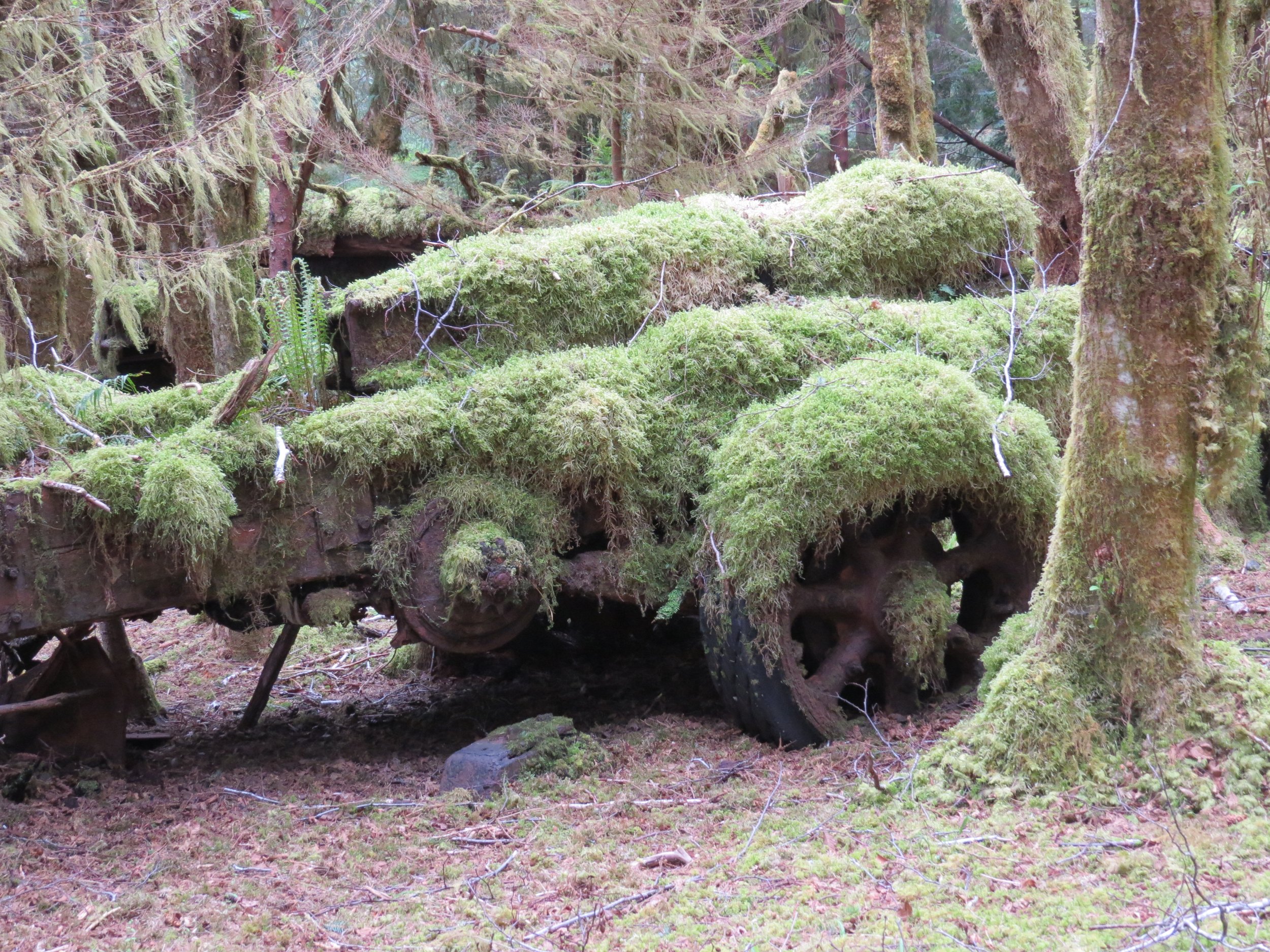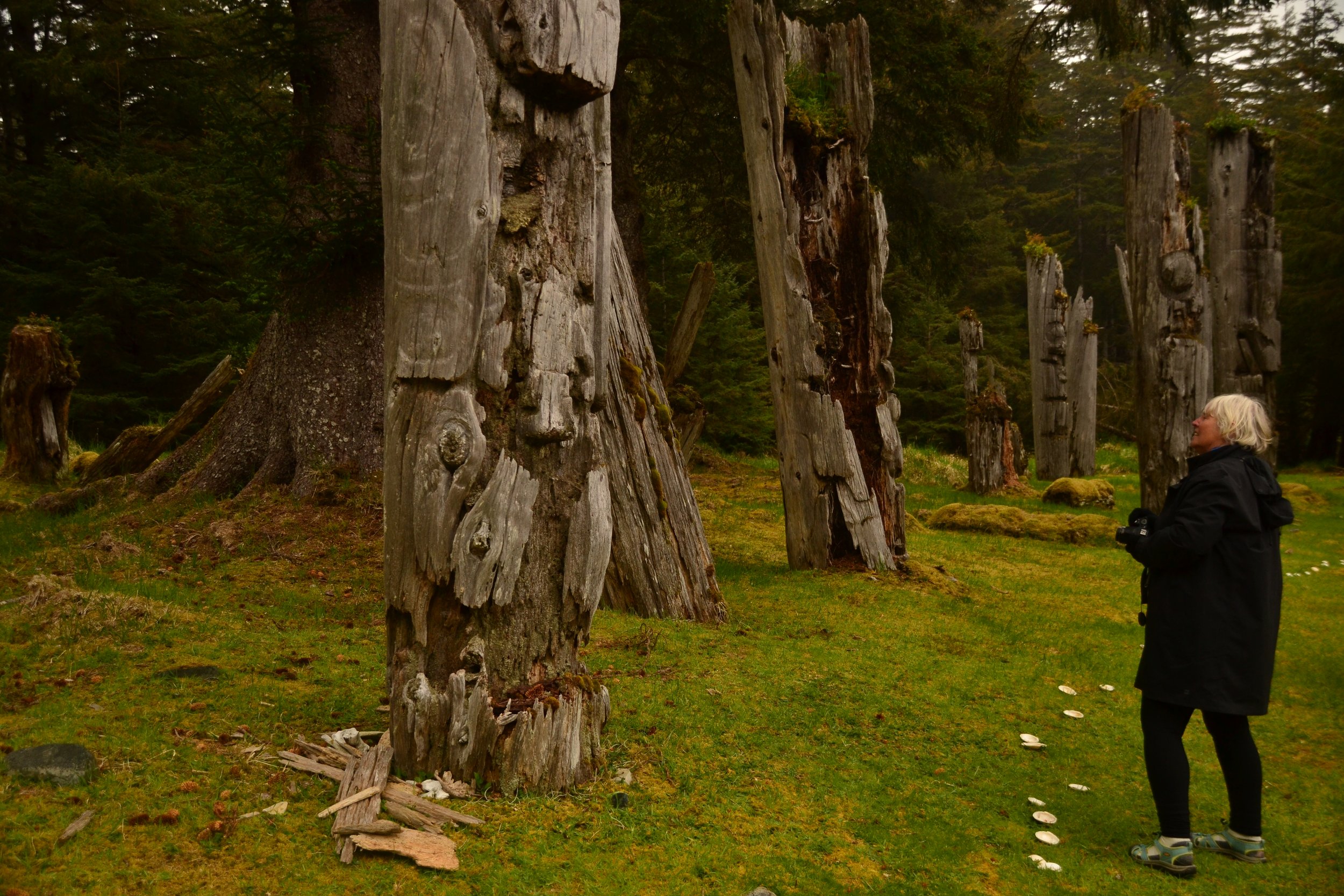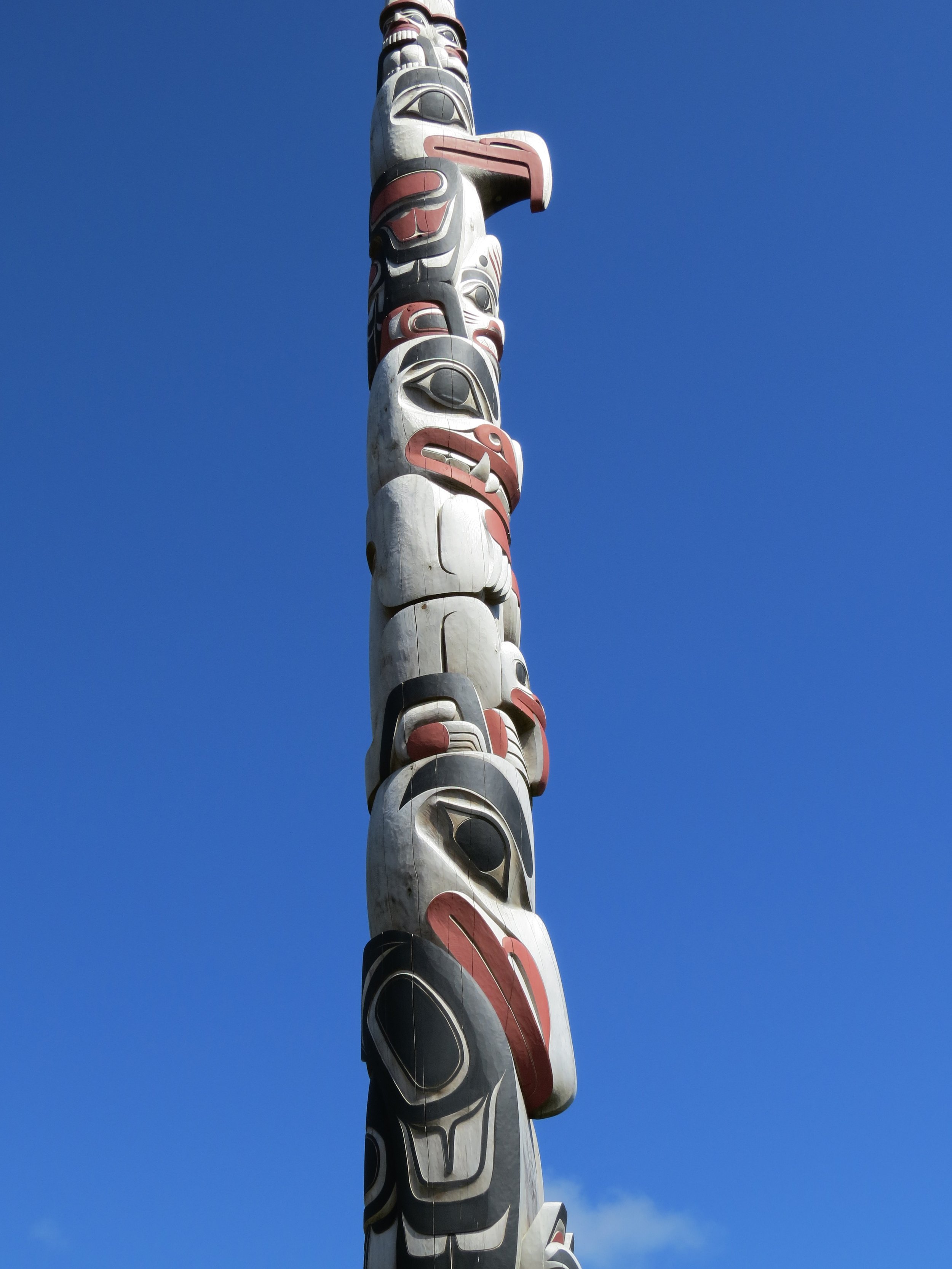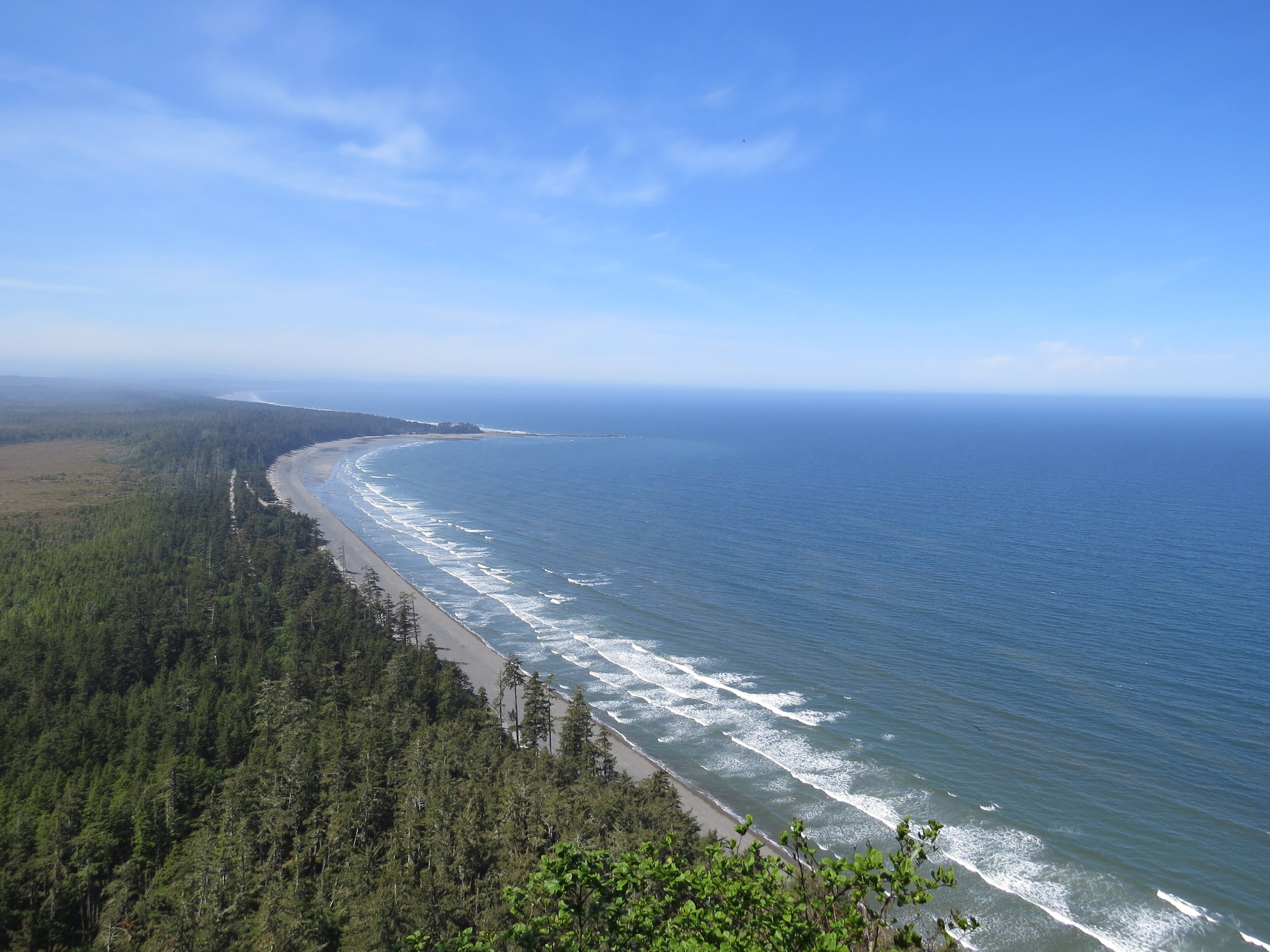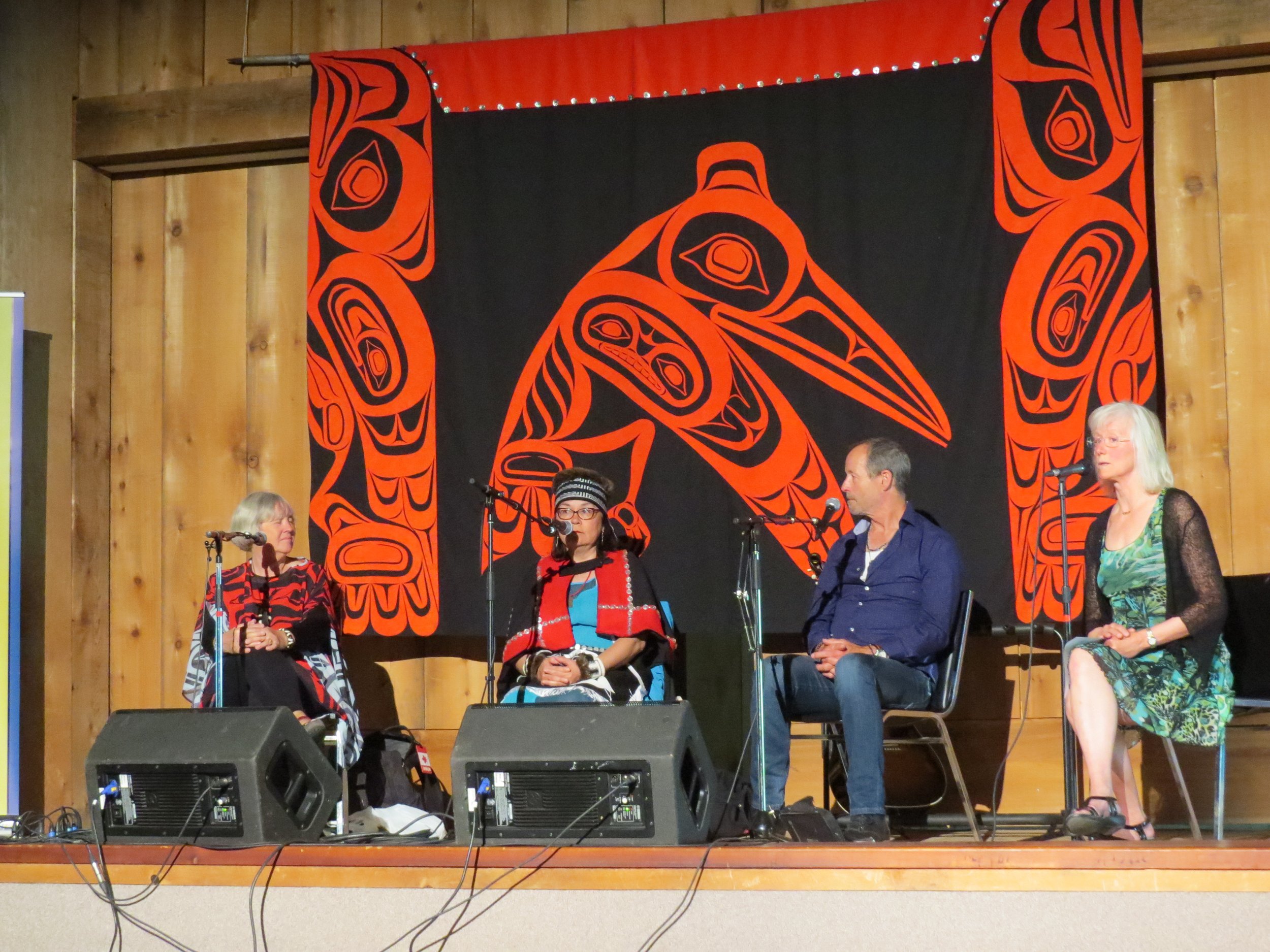Haida Gwaii - the very name conjures up images of windblown spruce clinging to rocks surrounded by foamy waves. Not unlike an Emily Carr painting.
Haida Gwaii had always been high on our wish list, so being invited to speak in schools and libraries here was pretty much a dream come true. From Vancouver, we flew into Sandspit, a tiny town on the north east shore of huge Moresby Island. Our son had often visited these remote islands and recommended we visit the very southern tip which is in a National Park called Gwaii Hanas. Basically the only way to reach this remote region is by a zodiak tour offered by a local wilderness company called Moresby Explorers.
We studied our options, counted our coins and decided to splurge on a four day trip with a photography theme. Moresby Explorers also owns a B & B in Sandspit so it was easy to walk out of the airport and find our accommodations just down the road. Seaport B & B is a newly built house with sweeping views of the water front. Eagles perched in the trees along the strait. Our room was plain but large with comfortable beds and warm cookies were waiting.
Our guide and skipper, Bryan, picked us up in the morning together with the five other guests with whom we would spend the next 4 days on a zodiak. We drove from Sandspit across a ridge of Moresby Island, on dirt logging roads, to Moresby Landing where we were outfitted with bibbed rain pants, a large rain jacket and gumboots. We’d live in these for the next few days. We wore undershirts, a sweater, a fleece jacket topped by our own rain jackets and then the provided rain gear over top, and finally a lifejacket. This meant we could only wobble like astronauts in a space suit…
This being the northern west coast, we had prepared ourselves for four days of driving rain, grey skies and grey waves. Fortunately, we ended up with only a half day rain and three-and-a-half days of blue sky and sun and/or cloudy but dry weather. Considering that Gwaii Hanas averages rain for about 230 days a year, we were lucky.
We had not even left the Landing when I spotted the first black bear browsing on the intertidal beach. The island’s bears have evolved to have much longer snouts than the mountain bears we are used to seeing. Like the Galapagos, even the same species of animals have made adaptations to different local environments resulting in, among others, a different sub species of stickleback fish in every lake. At least 39 distinct subspecies of plants and animals evolved in the archipelago, including seven mammals, three birds and fifteen species of the stickleback fish that are found nowhere else in the world.
We cruised across inlets, around Louise Island to spend the first night at Moresby Float Camp, the house anchored in a secluded fjord. The blue skies were mirrored in calm waters. We docked and were welcomed by two young women who cooked for us, with tasty appetizers, tea, coffee and hot chocolate. They even had a fireplace giving us much needed warmth to warm our chilled hands and feet. After a great dinner of bbq salmon, salad, veggies and rice we fell asleep in no time. Most of our fellow adventurers had brought along their own bottle of wine. We hadn’t realized you could do that. So if you like a glass of wine with your dinner, bring a bottle in your pack if you ever do this same adventure.
Moresby Float Camp
What a place for a morning coffee…
Moresby Float Camp has a large open living room, kitchen and bedrooms. There’s no shower but running water and regular toilets. Bedding was well organized: we took our (provided) sheets and pillowcases with us for 3 nights. The next morning we had fresh coffee, eggs, homemade bread, granola and yogurt before bundling up again. This became a ritual: two or three layers of warm clothes, thick socks and gloves. Then our own outer gear, the provided rain pants tucked into the gumboots and the rainjacket over top of everything else. By the time you can’t bend down anymore, you still have to maneuver into a lifejacket and into the waiting zodiak. We’d pull a warm hat and scarf over nose, mouth and face and then we were ready to zoom across the Hecate Strait to our next destination.
On our way across the ocean by zodiak to the most southern tip of Gwaii Hanas, we visited ancient village sites and remnants of totem poles in several sites: Skedans, Tanu, S’qang Gwaii, Rose Harbour and more. Each site has its own intrigue and charm. Skedans is a village site with house remnants and totem poles, but not as many as in the most southern tip S’qang Gwaii. Here, a mystical and misty atmosphere enhances the site where old spirits dwell and history is tangible. The bleached and weathered totems lean against moss covered house beams. The beach still tells stories of canoe ruts between rocks, where the “Vikings of the Pacific” showed their power by rowing long boats far east, north and south, taking slaves as they encountered other nations. I was intrigued to learn that a Haida Chief could marry a slave woman, thus making the former slave the most powerful matriarch of the clan. In this matriarchal society, men do as the leading woman dictates and children are part of their mother’s lineage.
I also learned about different totem poles: the shortest one were usually house poles, depicting the family’s clan and history. Tall plain poles with rings are potlatch poles, showing how many potlatches, or celebrations, have been held. Some poles are a memorial for a particular person, sharing his life story while yet others have a hollowed out square opening at the top housing a bentwood box of bones: a burial pole. Their silent stories are impressive and pay tribute to a society that lived here long before “contact” - as the period after the arrival of European explorers’ ships is called.
Houses were large, sometime dug down to allow for more space. Immense ceiling beams were held up by corner posts and closed by cedar walls. Now, all that remains is rounded beams covered in soft green moss, often with a new cedar tree growing on each corner as the trees reseeded. Slowly and silently, human history is swallowed up by the rain forest. The Haida people have chosen to let their history return to the earth, as it always has, rather than have Parks Canada follow their usual mandate of preserving history.
We were most impressed by the Watchmen. This ancient term refers to Haida who spend the summer in each historic location. They are provided a small house with a wood stove and basic comforts. Here they work for the summer, hosting visitors. They are extremely well spoken, gracious hosts with a wealth of knowledge about their people. Each host told us amazing stories. Haida Gwaii is made up of stories and the oral history seems alive and well. We heard stories of how people first came to populate the earth when Raven found a clamshell full of little people on Rose Spit. He pried open the shell and the people spilled out. Raven also brought light to the world. Bear married a woman who gave birth to bear cubs and in return he gave hunting powers to humans. There are many tales of super natural beings in this land - mostly, these are people wearing animal cloaks. Eagle, Raven, Whale, Bear - they all have specific powers and fascinating stories. Haida also strongly believe in reincarnation.
One of the men who told stories, told us of the impressive oral history. “When I was about 10 years old,” he said, “my uncle called me into his house and told me a 2 hour story. The next night I had to come back and tell the story back to him without embellishing, best as I could.”
This repeated night after night until he had memorized much of his own history. The tradition continues today as he tells his daughter the ancient tales and makes her tell them back to him.
We learned to chew spruce tips and licorice root. And ate herring roe on kelp… As far as wildlife goes, we saw many, many eagles. A few glimpses of whales as well as two bears.
Rose Harbour
One overnight was spent in Rose Harbour, an old whaling station. Much debris, buildings and rusty tools recall an era when people caught and processed whales for oil. I found it a sad place to be. The lone woman who lives here, offers a guest house and meals to Moresby Explorers. We ate greens from her immense garden and freshly caught ling cod. In the morning she ground grains while riding her converted exercise bike to make us pancakes with rhubarb sauce from the garden. An outhouse and wood heated shower made this into a rustic adventure.
Our zodiak adventure ended with whale sightings on Hecate Strait. After returning to Sandspit, I did readings in the local elementary school, hosted by Haida Gwaii Literacy. I find it so impressive that people in this remote, northern location have opted to sponsor Syrian refugees. Haida Gwaii is one of the most peaceful locations in earth. I can’t begin to imagine how the Syrians feel to be here. I met a lovely young couple, both of them working hard on learning English and holding jobs. In Queen Charlotte City I met a gracious family with young children, one of whom lost her leg in a bombing. It is heartwarming to see how the community has embraced “their” family. Friends drive the children to ballgames, the parents to English lessons, they bake cakes and help with shopping. The Syrian family may have left behind relatives, but they gained many new aunts and uncles in Haida Gwaii.
I did readings and presentations in lovely schools and libraries all along the coast from Charlotte in the south to Masset in the north. I walked into one school to find that the power was out in the entire village. “Yeah, that happens often,” the principal said with a shrug, “probably an eagle that flew into a power line.”
In another village I asked directions to a house. “Turn right after three pole lengths,” was the answer.
Charlotte has a great Visitors Centre with information and maps. And whales circled and spouted along the shore every day. One of the most impressive places to visit is Skidegate’s Museum and Interpretive Centre. This massive wooden longhouse, has a museum that houses ancient totems and other carvings, paintings, photos, costumes, woven hats and tools. The place gives you a great glimpse into Haida history and culture. I highly recommend visiting here before exploring the island.
Skidegate has a First Nation’s village with beautiful longhouses and totem poles along the water front. A long house is a traditional house - often a community centre - with massive ceiling beams and square posts on each corner. I was so very lucky to come back here for a second visit and witness a real potlatch.
The Unity Pole of Skidegate was erected fairly recently. Driving north, the tiny village of Tlell has several art studios and a great bookstore. We spotted sandhill cranes in a field nearby and walked on pebbly beaches, including Balance Rock where we looked for crabs while eagles watched us.
Port Clements is a logging and fishing village with a great library. We hiked the Golden Spruce trail. If you ever go here, be sure to first read the book The Golden Spruce by John Vaillant.
Finally we reached the northern town of Masset. It is small but full of colourful characters and history. I was surprised to find market tables full of produce and bakings in the middle of town. Traditional Mennonites live on homesteads nearby and bring their garden produce, cakes and breads into town to sell. The library in Masset is a gorgeous old log cabin. I enjoyed doing a presentation surrounded by honey coloured logs lines with books. Be sure to pop into the Secret Garden behind the RCMP office, where you can sit on a solid wooden bench among flowers and blossoms.
From Masset it is only about 2 KM to the First Nations town of Old Massett. Again, longhouses and totem poles indicate that you are now in a traditional village. I stayed in the spacious Haida Lodge, which looks like a small bungalow from the street but turned out to be much larger with spacious rooms. The very kind lady who made our breakfast, told us that her husband is a carver. How lucky we were to be invited into the carving shed. Here we watched in awe as two men carved a 60’ cedar. They each had a tiny chisel and carefully worked along the pencil lines, making figures appear. 10’ of the pole will go into the ground, and many tonnes of rock will be used to keep it firmly in place. We were told that it will take 400 people to raise the massive pole. Besides several poles, there were also longboats in the shed. Their traditional paintings in red and black make for an awesome sight. We felt very privileged to see this ancient art in progress.
From Masset we drove to the end of the road. First we passed an icon: an old, painted hippy school bus in the bush, famous for the cinnamon buns that are baked and served here. Next, we strolled along agate beach, of course picking up several agates.
Then came Tow Hill - an important spot in Haida culture. We climbed the hill to admire the view of the open West Coast sand beaches and learned more Haida legends. The view here is of Rose Spit, where the first Haida people originated. I found it fascinating to learn that a clan can own a story or a song. Stories and songs can be given to another clan, and then the original clan that gave it away can no longer sing the song or tell the story.
Rose Spit
We walked on North Beach and saw the outline of Alaska’s most southern islands across the water. Haida Gwaii is a fascinating place. It can be cold and windy. But its people and their culture make this a heart warming place, of gracious hosts and intriguing tales.
On my last night, I was honoured to be poet laureate during a fundraiser evening for Haida Gwaii Literacy. The dinner included herring roe and rice with seaweed, as well as three different kinds of salmon. What a thrill to share the stage in the gorgeous longhouse with a traditional Haida storyteller who spoke in Haida, and with award winning musicians. As I left the islands to come home, I got hugs in the airport from newly made friends. Haida Gwaii is a very special place and I feel very privileged to have witnessed it.
Storytelling for Haida Gwaai Literacy.



